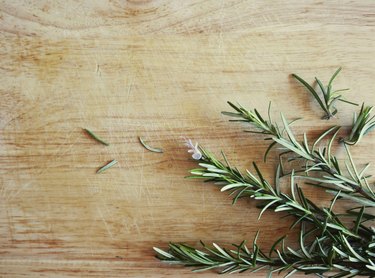
Legend has it that where a rosemary bush (Rosemarinus officialis) thrives in a garden, a woman is in charge of the household. Fortunately for womankind, this vigorous herb grows well outdoors in most Mediterranean climates as an easy-care and drought-resistant evergreen. While the species plant's flowers turn hillsides lilac in sunny Spain and Italy, its myriad cultivars offer variety in form and color.
On the Wild Side
Video of the Day
All rosemary comes from the wild European shrubs that grow taller and wider than you'd probably want, with shiny, thin, needlelike leaves 1 inch long, dark green above and pale below. The leaves have a pungent, piney fragrance. The flowers appear toward the ends of branches in clusters of frothy blue or violet, each with an upper and lower "lip." Rosemary prefers acidic, sandy soil and benign neglect in a garden in U.S. Department of Agriculture plant hardiness zones 8 through 10. Established plants rarely need supplemental watering.
Video of the Day
Upright Alternatives
Whether you are looking for a new cultivar or trying to identify one in your yard, start with the form. Many cultivars grow upright, like the species plant, but are distinguishable by other features. "Arp" grows as an upright bush, 4 feet in both directions. Recognize it by the pale, almost white flowers and the lemony nuances of its fragrance. Beautiful "Foresterii" never gets taller than 3 feet tall, but its flowers are sapphire and its foliage thick and dark. "Tuscan Blue" also produces deep blue flowers but grows in a column, 6 or 7 feet high and 3 feet wide. For red flowers, there's "Red Flowered" cultivar, only 2 feet tall. Rosemary cultivars in general grow in USDA zones 8 through 10; "Arp" is the exception to the rule, because it grows in USDA zones 7 through 10.
Pleasure Domes
Semi-upright rosemary cultivars form rounded clumps. One to try is "Boule," a French word that rhymes with rule and means ball. It grows in a dome about 3 feet in each direction. For slope planting, consider "Collingwood Ingram." It grows about 2 feet tall and at least twice that wide, spreading so continually that the woody trunk is completely hidden. Another good choice for hills is "Ken Taylor," with its eye-catching flowers in deepest blue.
Long and Lovely
If trailing rosemary interests you, there are some beautiful creepers. "Postratus" got its name from its prostrate form, and is the classic creeping rosemary. It works well in containers and rock gardens with its twining stems that wend their way between stones or cascade down from pots. This cultivar only rises 1 foot, but it spreads out 2 feet, and its fragrance strongly resembles pine. "Roman Beauty" is another dwarf trailer, its compact gray-green foliage cascading happily over a low wall. For larger blue flowers, try "Irene," a delightful draper and creeper with lighter-colored foliage. If you want a slightly taller plant, "Huntington's Carpet" heads up 18 inches before spreading its stems out to 6 feet and is useful in preventing erosion on a slope. It also produces pale blue flowers and light-colored foliage.
- The United State National Arboretum: The Right Rosemary
- Floridata: Rosemary
- San Marcos Growers: Rosemary
- Fine Gardening: Rosemary Indoors and Out
- Sunset: The Right Rosemary for You
- National Gardening Organization: All About Rosemary
- Portland Nursery: Rosemary
- Monrovia: "Huntington Carpet Rosemary"
- Monrovia Announces New Plant Varieties ("Roman Beauty")